Sage and Coombe Architects
T. Kelly Wilson, Timothy Dunne, John Parker, Richard Kress, Peter Hansen, Christoph Timm, Peter Coombe, Allen Slamic, John Reed
Designed for Site #2 in Abu Dhabi, between Saadiyat Island and Yas Island.
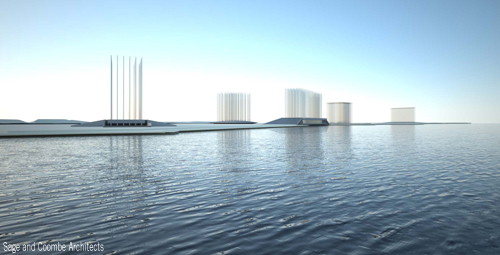
Design Submission for the 2010 Land Art Generator Initiative Design Competition
Artist’s descriptive text:
One edge of this site is the line between two extreme conditions: the Rub al Khali and the Arabian Gulf. Here the desert meets water. The forms of our proposal are drawn from the interaction of the environmental conditions and the unique land forms of the Arabian Desert’s Empty Quarter.
Solar Sound Field responds to the scale of the site and creates an alternate landscape of forms that will be seen from afar while providing an unexpected and sublime experience for an individual visitor. The composition of objects across the site is reminiscent of geological forms found in the desert, the Jebel Tuwaiq for example. We created these primal forms as a child may play on a beach: we dig to expose water; we smooth the sand to create a protected place; we mound the sand to make a landscape; and we dig by the sea and watch as it invades.
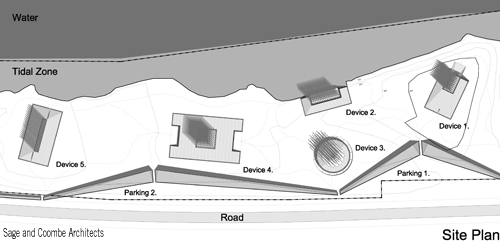
To generate electricity we harvest the most prevalent source of energy on the site- solar radiation. It is well established that all the energy stored in Earth’s reserve of fossil fuels from petroleum to coal, is matched by the energy from just three weeks of sunshine. Each square meter collects the approximate energy equivalent of roughly a barrel of oil each year, or 6 kilowatt-hours of energy every day in the desert.
Solar chimneys will capture energy from the sun’s heat and photovoltaic cells create energy from the sun’s light. We want to transform the latent energy of the site into a medium that can be seen, felt and heard. We give voice to the desert: we propose five musical machines and five accompanying musical compositions.
Each machine is designed and placed to address a unique condition of the site and provide a different orientation to the ground plain. The generated sounds, ordered and organized into modern compositions, and are acoustically matched to the spatial idea and position of the viewer as he moves from one chamber to the next.
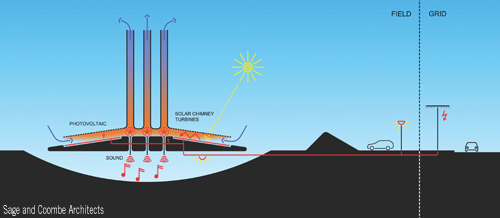
The Machines
Each machine is a composition of three components: an acoustic chamber, a glass skirt and an array of chromium steel pipes- 60 meters tall. The elements of the site- water, sand and air are represented in glass, concrete and polished steel. The glass skirts will float above the sand like a mirage of water. The colour of water, sand and sky are reflected and distorted in the mirror finish of the pipes. The pipes will dissolve into the sky. The concrete is made from the surrounding sand and will be come a part of the ground.
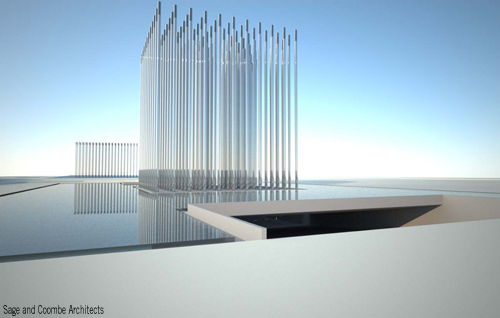
Air underneath the glass skirts at the base of the pipes will be heated by the sun and an upward directed airstream created by the hot and buoyant air wanting to rise. This airflow, similar to an organ, provides the means to sustain a musical note through the resonance chamber in each solar chimney. The pipes will channel the airflow that drives a simple turbine and generates electricity. Water storage underneath the glass skirt will be used to store heat so that the stack effect continues throughout the night. The harvesting energy will be felt and heard throughout the day.
In addition to the turbines, electricity is generated by of 24,000 square meters of photovoltaic cells placed below the glass skirts. The electricity created will provide power needed on site. Excess power will be fed to the grid.
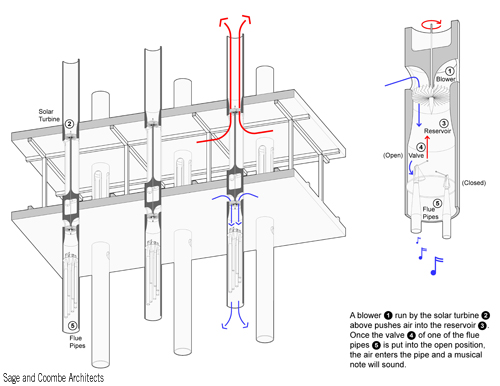
Parking Area
A continuous dune, made from the excavations or spoils from the sound chambers, lines the parking and provides an acoustical barrier to the road. Separate entrances punctuate the dune. A visitor, upon leaving the parking area, would pass through the dune and follow pathways that link each machine. Descending into the cool shade of each chamber the visitor will find a symphony of sound, space and light.
Machine 1 Amphitheatre remains an ‘instrument.’ The available sound is offered the visitor to manipulate, and to be used by visiting sound artists and musicians who come with the purpose to explore the form of generated sound.
Musical Composition 1:
Suspension Chamber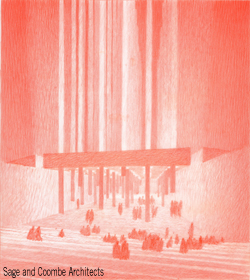

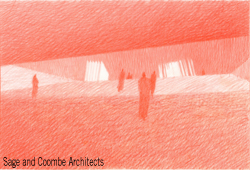
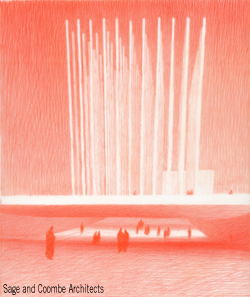
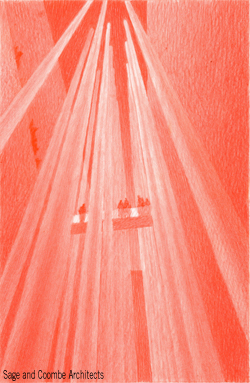
Here the unpredictability of the converging counterpoints – disparate and dynamic voices unpredictably bouncing off one another – form moments of intense epiphany and inner-directed rumination engendered by an encounter with the surrounding spaces and energy.
Machine 2 Water permits the confluence of tidal water within the sound chamber, low frequency notes at the limit of human hearing visually observable on the surface of the water, registering their notes with pressure.
Musical Composition 2:
Performance Chamber
Out of the stillness of the water grotto rises a sonic wave of resonating low frequencies. The cluster of tones first presents itself as an inaudible sound wave somewhere that sends ripples over the surface before modulating and becoming humanly audible. Our eyes are presented with one image of water and faint light and our ears remind us of their voluminous powers.
Machine 3 Sky slides land beneath an inverted dome that is pierced by an oculus, brings the visitor to direct their gaze toward the sky.
Musical Composition 3:
Water Chamber
With a blast of direct sunlight at the center of this massive disc the heavens cut through our senses like the bright, soaring major harmonies created by layers upon layers of melodic threads. The sun’s radiance appropriately trails-off into the sounds of creation – birds of the sky.
Machine 4 Wadi develops a long and gradual swale to pass gently under the land, slowly approaching the sound field beneath the pipes above where the slow gradient of descent compliments the gradient of sound.
Musical Composition 4:
Sky Chamber
Two wind instruments, like comforting messengers from the heavens directed columns and conversing a tonal language at home in the Arabic culture, beckon the visitor along a graded pathway leading further into a blissful unknown.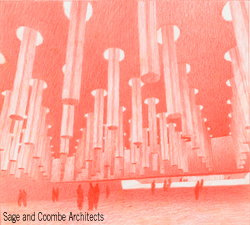
Machine 5 Canyon directs the visitor into a deep trench down a ramp, to cross a bridge poised exactly at the mid point between top and bottom of the trench. With equal measures of space above and below, the visitor is placed in a suspension from ground and sky.
Musical Composition 5:
The vast stretch of upwards and downwards space is not inert but charges with the sound of arching and jubilant brass. Suspended and locked into some kind of celestial dance above the insistent gravitas of the string bass pizzicatti the stifled awe of an encounter with the sublime is given over to joyously pulsating celebration.
Scientific Principles: Solar Updraft Function of LAGI
The basic function of LAGI is to use the heating of air as in a greenhouse to produce power from updraft to turn a turbine.
The project consists of five differently geometrically shaped machines which operate independently from one another. They are located at distances of 100 to 400 meters apart.
Functional Principles
The function of each of the five machines can be divided into three parts, each of which derives from traditional and conventional technology.
1. Greenhouse– heating of the air,
2. Chimney– upward motion of hot air through the towers, and
3. Turbines– generation of electricity by turning of a turbine.
Greenhouse
The solar radiation penetrates the glass roof of a greenhouse a heats the air below. This is similar to what happens in a car parked in the sun, the air will heat up until there is an equilibrium of the energy irradiated into the box and the total of the energy radiated out of the box and the energy loss by heat conduction through floor, walls and roof.
The real model must include the loss of the hot air to the actually not enclosed “box”. A dynamic flow model includes inflow of cold air into the greenhouse, transport of that air through the greenhouse structure while the air is heated, and loss of hot air from the greenhouse to the chimney(s).
Chimney
Hot air rises as it is less dense than cold air. The rising hot air from the greenhouse or glass skirt turns powers the turbines.
Turbines
To calculate the potential for energy production from the turbines placed in the solar chimneys we have looked for existing installation that may serve as precedent.
Power Calculations and Precedent Projects
Related Posts
2 Comments
Add comment Cancel reply
This site uses Akismet to reduce spam. Learn how your comment data is processed.

Oh this is fantastic!!! I hope it gets built,and that will inspire me to visit Abu Dhabi. Good luck getting this off the ground. I am so eager to listen to this music…
[…] through the towers, and Turbines– generation of electricity by turning of a turbine. Source: Land Art Generator Initiative Reageer […]